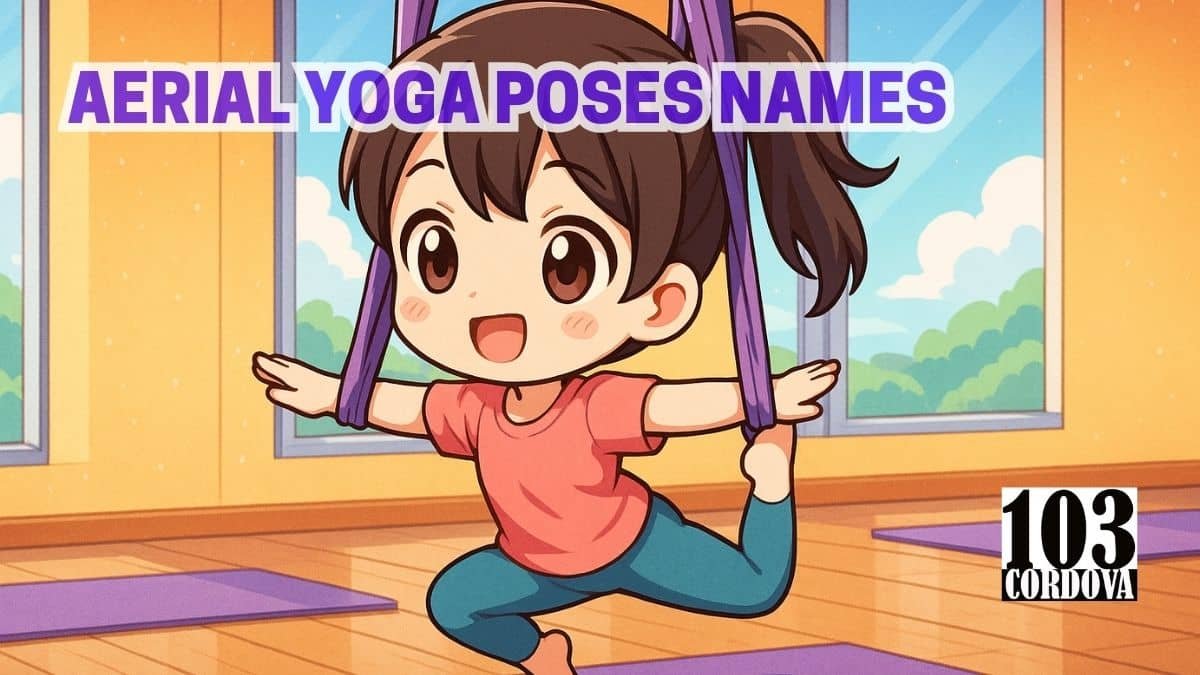Learning aerial yoga poses names can make your practice more organized and less stressful.
When you know what a pose is called, you can match instructions to actions more quickly.
This prevents confusion during class and allows you to focus on how your body feels in the fabric.
It also builds confidence because you will not feel lost when hearing new directions.
We’ll share simple steps that will help you remember pose names with ease.
1. Importance Of Knowing Aerial Yoga Pose Names
Knowing aerial yoga poses names helps you stay safe because you can prepare for movements in advance.
It allows you to follow the teacher’s guidance without hesitation.
When everyone in a class understands the same words, the flow of practice is smoother.
It also helps when reading or watching tutorials since you can match the names to what you see.
Clear knowledge of pose names makes your practice more effective and less frustrating.
🧘 Exploring the Benefits of Meditation and Yoga
2. Common Aerial Yoga Terminology
Certain words appear often in aerial yoga, and learning them can make pose names less confusing.
In many classes, you will hear the word “hammock,” which refers to the fabric that supports your body during the practice.
The term “invert” is also common and means turning your body upside down in poses that shift your balance.
Another useful word is “wrap,” which describes how the hammock or aerial silk is looped around parts of your body for stability.
These simple terms provide hints about the actions required in each pose.
When you know them, it becomes easier to understand longer or more advanced pose names.
They also help you follow instructions faster because you already know what the teacher means.
With practice, these basic terms will feel natural and make aerial yoga more approachable.
🧘 Surprising Benefits of Yoga for Health You Need to Know
3. Foundational Aerial Yoga Poses
It is easier to remember new names when you start with the basic poses because they introduce you to the core movements.
Star, chair, and butterfly are simple asanas that teachers often use in beginner classes.
These poses train you to hold proper posture while also getting comfortable with the hammock.
When you practice aerial yoga regularly, these basics become second nature and prepare you for more complex poses.
They also help you understand how weight shifts and balance work in the fabric.
Many advanced asanas are built from the same shapes you learn at the start, so the transition feels less overwhelming.
By learning the names of these foundational poses, you build a clear link between movement and word.
This strong base makes it easier to recognize and remember new aerial yoga poses as your skills grow.
🧘 How the Benefits of Daily Yoga Can Transform Your Life
4. Using Visual Aids And Flashcards
Images are powerful tools for remembering aerial yoga poses names.
Flashcards with pictures on one side and names on the other can turn studying into a quick daily activity.
You can review them before class or during free time.
Visual aids also work well when practicing at home because you can compare your pose to the image.
This method makes the learning process less overwhelming and more engaging.
🧘 Why Bear Pose Yoga Is Essential for Building Core Strength and Stability
5. Breaking Down Complex Pose Names
Some poses have long names that may seem hard to remember.
Splitting them into smaller words helps you see patterns and meaning.
For instance, a name with “open” often signals wide arm or leg positions.
When you connect each part of a name to its action, recall becomes easier.
This simple breakdown method can turn a confusing name into something memorable.
🧘 The Holistic Benefits Of Ashtanga Yoga: Physical, Mental, and Beyond
6. Practicing Verbal Cues And Repetition
Speaking pose names out loud while practicing builds stronger memory links.
Repetition allows your brain to connect the sound of the word to the movement.
Teachers often use the same cues during class, so repeating them at home prepares you to respond faster.
You can also record yourself saying the names and play them back during practice.
In time, repeating names will help you remember them without much effort.
🧘 Long-Term Health Benefits of Ashtanga Vinyasa Yoga for Aging Well
7. Origins And Meanings Of Pose Names
Many aerial yoga poses names come from traditional yoga roots.
To illustrate, names that mention animals often reflect the shape or energy of the pose.
Some are based on shapes like a star or a bow, which describe the body’s outline.
Knowing these origins makes the names more meaningful and easier to recall.
This knowledge also helps you feel connected to the tradition behind the practice.
🧘 Unlocking the Hidden Benefits of Facial Yoga for a Youthful Appearance
8. Joining Group Classes And Tutorials
Hearing pose names repeatedly in group settings helps your memory.
Watching tutorials online allows you to pause and repeat the name while practicing.
Group classes also provide the chance to ask questions if a name is unclear.
Observing others perform poses while the teacher calls out names strengthens the link between word and movement.
Both methods give you steady practice with real examples.
🧘 Exploring the Top Benefits of Asana Yoga for a Healthier You
9. Keeping A Personalized Pose Name Journal
Writing down aerial yoga poses names in a notebook helps you strengthen your memory and build focus.
You can include small drawings or notes about how each pose feels in your body, such as how it stretches the spine or supports the lower back.
Recording details like whether your glutes are engaged can remind you of the muscles involved in the movement.
This personal touch makes your journal more than just a list of names; it becomes a guide to how each pose connects to your practice.
Reviewing the journal before class gives you a quick way to refresh your memory and prepare for the session.
Over time, your notes will grow into a detailed reference that reflects your progress.
This process also encourages you to pay closer attention during practice since you know you will be writing about it later.
A personalized journal is both a learning tool and a record of how your body and skills develop.
🧘 What Makes Air Yoga Poses Unique Compared to Traditional Yoga?
10. Testing Knowledge And Tracking Progress
Regularly testing yourself on pose names helps you see how much you are improving over time.
Flashcards are useful, but you can also write the names from memory or ask a friend to quiz you for variety.
Paying attention to which names are harder to recall shows you where to spend extra practice.
You can even connect names to how certain poses feel in your body, such as a backbend that stretches the chest and improves posture.
Tracking these details also helps you notice changes in your range of motion as you practice more often.
Small goals, like learning three new names each week, make the process easier to manage.
By checking your progress in this way, you create a clear system that supports steady learning.
💡 Conclusion
Learning aerial yoga poses names is a skill that builds gradually with practice.
By using tools like flashcards, journals, and repetition, you can remember names more easily.
Group classes and tutorials offer real-life exposure to reinforce what you study at home.
Understanding the meanings and roots of names adds depth and makes recall easier.
With steady effort, remembering these names becomes natural and helps you enjoy practice more fully.
🤝 Our Services
At 103 Cordova Activity Space, we offer yoga classes designed for all ages and skill levels.
Our classes help improve strength, flexibility, and relaxation in a supportive environment.
You can find us at 103 Cordova Tower, Marquinton Residences, Cirma Street, Sto.
Nino, Marikina City.
For questions or bookings, call us at 0917-622-5780, reach us on Facebook, or use the contact form on our site.
Join us and enjoy a healthier lifestyle through regular yoga practice.
FAQs
1. What are the easiest aerial yoga poses names for beginners to learn?
Basic poses like Star, Chair, and Butterfly are usually the easiest to start with because they form the foundation of many other poses.
Learning these helps you build confidence and recognize pose patterns.
2. How can I remember the names of complex aerial yoga poses?
Break down long names into smaller, meaningful parts and connect each part to the action or shape in the pose.
Using flashcards, repetition, and visual aids can also make memorization easier.
3. Why is it important to know aerial yoga poses names before attending a class?
Knowing the names helps you follow instructions quickly and accurately, reduces confusion, and allows you to focus on your body’s alignment and form during the practice.
4. Can learning poses names improve my safety during aerial yoga practice?
Yes.
Understanding the names prepares you for the movements ahead, so you can position yourself safely and avoid injuries by anticipating transitions and inversions.
5. What tools or resources are best for memorizing aerial yoga poses names?
Visual aids like flashcards, personalized journals, group classes, online tutorials, and verbal repetition are effective tools for reinforcing your memory and making learning more engaging.

